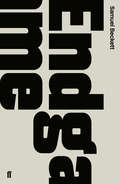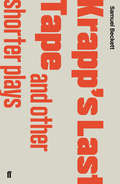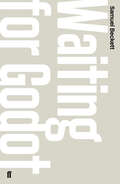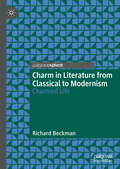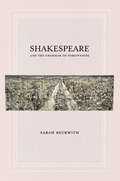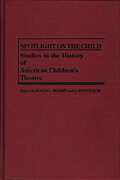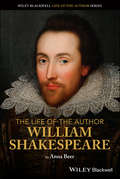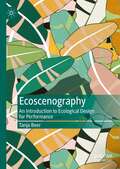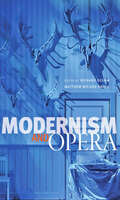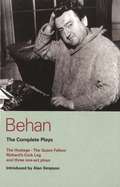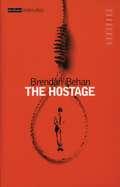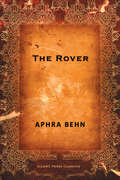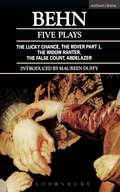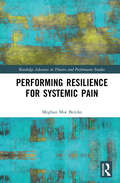- Table View
- List View
Endgame: A Play In One Act: A Mime For One Player: Act Without Words (Theatrical Notebooks Of Samuel Beckett Ser. #Vol. 2)
by Samuel BeckettOriginally written in French and translated into English by Beckett, Endgame was given its first London performance at the Royal Court Theatre in 1957.HAMM: Clov!CLOV: Yes.HAMM: Nature has forgotten us.CLOV: There's no more nature.HAMM: No more nature! You exaggerate.CLOV: In the vicinity.HAMM: But we breathe, we change! We lose our hair our teeth! Our bloom! Our ideals!CLOV: Then she hasn't forgotten us.
Happy Days: A Play In Two Acts
by Samuel BeckettHappy Days was written in 1960 and first produced in London at the Royal Court Theatre in November 1962.WINNIE: [ . . .] Well anyway - this man Shower - or Cooker - no matter - and the woman - hand in hand - in the other hands bags - kind of big brown grips - standing there gaping at me [...] - What's she doing? he says - What's the idea? he says - stuck up to her diddies in the bleeding ground - coarse fellow - What does it mean? he says - What's it meant to mean? - and so on - lot more stuff like that - usual drivel - Do you hear me? He says - I do, she says, God help me - What do you mean, he says, God help you? (stops filing nails, raises head, gazes front.) And you, she says, what's the idea of you, she says, what are you meant to mean?
Krapp's Last Tape and Other Shorter Plays: All That Fall, Act Without Words, Krapp's Last Tape, Cascando, Eh Joe, Footfall, Rockaby And Others (Faber Drama Ser.)
by Samuel BeckettKrapp's Last Tape was first performed by Patrick Magee at the Royal Court Theatre in October 1958, and described as 'a solo, if that is the word, for one voice and two organs: one human, one mechanical. It fills few pages. It is perhaps the most original and important play of its length ever written.' (Roy Walker)The present volume brings together Krapp's Last Tape and Beckett's other shorter works or 'dramaticules' written for the stage. It will be complemented by a forthcoming Faber edition of dramatic works written for radio and screen. Arranged in chronological order of composition, these shorter plays exhibit the laconic means and compassionate ends of Beckett's dramatic vision. KRAPP 'Here I end this reel. Box - [Pause.] - three, spool - [Pause.] - five. [Pause.] Perhaps my best years have gone. When there was a chance of happiness. But I wouldn't want them back. Not with the fire in me now. No, I wouldn't want them back. [Staring motionless before him.]
Waiting for Godot: A Tragicomedy in Two Acts (Faber Drama Ser.)
by Samuel BeckettSubtitled 'A tragicomedy in two Acts', and famously described by the Irish critic Vivien Mercier as a play in which 'nothing happens, twice', En attendant Godot was first performed at the Théâtre de Babylone in Paris in 1953. It was translated into English by Samuel Beckett, and Waiting for Godot opened at the Arts Theatre in London in 1955. 'Go and see Waiting for Godot. At the worst you will discover a curiosity, a four-leaved clover, a black tulip; at the best something that will securely lodge in a corner of your mind for as long as you live.' Harold Hobson, 7 August 1955'I told him that if by Godot I had meant God I would have said God, and not Godot. This seemed to disappoint him greatly.' Samuel Beckett, 1955
Charm in Literature from Classical to Modernism: Charmed Life
by Richard BeckmanCharm in Literature from Classical to Modernism: Charmed Life discusses charm as both an emotional and aesthetic phenomenon. Beginning with the first appearance of literary charm in the Sirens episode of the Odyssey, Richard Beckman traces charm throughout canonical literature, examining the metamorphoses of charm through the millennia. The book examines the works of Chaucer, Spenser, Shakespeare, Milton, Pope, Wordsworth, Coleridge, Proust, Joyce, Mann, and others, considering the multiplicity of ways charm is defined, depicted, and utilized by authors. Positioning these poems, dramas, and novels as case studies, Beckman reveals the mercurial yet enduring connotations of charm.
Shakespeare and the Grammar of Forgiveness
by Sarah BeckwithShakespeare lived at a time when England was undergoing the revolution in ritual theory and practice we know as the English Reformation. With it came an unprecedented transformation in the language of religious life. Whereas priests had once acted as mediators between God and men through sacramental rites, Reformed theology declared the priesthood of all believers. What ensued was not the tidy replacement of one doctrine by another but a long and messy conversation about the conventions of religious life and practice. In this brilliant and strikingly original book, Sarah Beckwith traces the fortunes of this conversation in Shakespeare’s theater. Beckwith focuses on the sacrament of penance, which in the Middle Ages stood as the very basis of Christian community and human relations. With the elimination of this sacrament, the words of penance and repentance—"confess," "forgive," "absolve" —no longer meant (no longer could mean) what they once did. In tracing the changing speech patterns of confession and absolution, both in Shakespeare’s work and Elizabethan and Jacobean culture more broadly, Beckwith reveals Shakespeare’s profound understanding of the importance of language as the fragile basis of our relations with others. In particular, she shows that the post-tragic plays, especially Pericles, Cymbeline, The Winter’s Tale, and The Tempest, are explorations of the new regimes and communities of forgiveness. Drawing on the work of J. L. Austin, Ludwig Wittgenstein, and Stanley Cavell, Beckwith enables us to see these plays in an entirely new light, skillfully guiding us through some of the deepest questions that Shakespeare poses to his audiences.
Spotlight on the Child: Studies in the History of American Children's Theatre (Contributions in Drama and Theatre Studies)
by Roger L. Bedard C. John TolchAlthough children's theatre has been a part of American culture from early times, historians have not always included it in the documentation of our theatrical heritage. Sometimes more the product of the educator and the social worker than the producer or the theatre artist, theatre with and for young people has been neglected in traditional theatre history studies; yet as early as 1792 Charles Stearns began creating his plays and dialogues for school children. The traditions and success of eighteenth-century school drama inspired social workers to explore similar activities in their playground and settlement house work, and at the end of the nineteenth and the beginning of the twentieth century, professional producers began experimenting more vigorously with the commercial possibilities of children as audience.This book is a collection of essays by leading authorities in the field on various aspects of the historical development of children's theatre in the United States. The discussions focus on the marked differences that have occurred from group to group and examine the ways in which children's theatre began to find definition, as theorists and writers such as Winifred Ward and Charlotte Chorpenning strove to articulate the differences between the child as participant in creative drama and the child as audience member. The introduction provides a review of early concepts and the evolution of present-day thought, and the essays illuminate facets of the rich and varied history of American theatre with and for children. This trailblazing study will serve as the beginning of a fuller understanding of the field and a challenge to others to document the missing pieces.
The Life of the Author: William Shakespeare (The Life of the Author)
by Anna BeerDiscover an invigorating new perspective on the life and work of William Shakespeare The Life of the Author: William Shakespeare delivers a fresh and exciting new take on the life of William Shakespeare, offering readers a biography that brings to the foreground his working life as a poet, playwright, and actor. It also explores the nature of his relationships with his friends, colleagues, and family, and asks important questions about the stories we tell about Shakespeare based on the evidence we actually have about the man himself. The book is written using scholarly citations and references, but with an approachable style suitable for readers with little or no background knowledge of Shakespeare or the era in which he lived. The Life of the Author: William Shakespeare asks provocative questions about the playwright-poet’s preoccupation with gender roles and sexuality, and explores why it is so challenging to ascertain his political and religious allegiances. Conservative or radical? Misogynist or proto-feminist? A lover of men or women or both? Patriot or xenophobe? This introduction to Shakespeare’s life and works offers no simple answers, but recognizes a man intensely responsive to the world around him, a playwright willing and able to collaborate with others and able to collaborate with others, and, of course, his exceptional, perhaps unique, contribution to literature in English. The book covers the entirety of William Shakespeare’s life (1564-1616), taking him from his childhood in Stratford-upon-Avon to his success in the theatre world of London and then back to his home town and comfortable retirement. The Life of the Author: William Shakespeare sets his achievement as a writer within the dangerous, vibrant cultural world that was Elizabethan and Jacobean England, revealing a writer’s life of frequent collaboration, occasional crisis, but always of profound creativity. Perfect for undergraduate students in Literature, Drama, Theatre Studies, History, and Cultural Studies courses, The Life of the Author: William Shakespeare will also earn a place in the libraries of students interested in Gender Studies and Creative Writing.
The Life of the Author: William Shakespeare (The Life of the Author)
by Anna BeerDiscover an invigorating new perspective on the life and work of William Shakespeare The Life of the Author: William Shakespeare delivers a fresh and exciting new take on the life of William Shakespeare, offering readers a biography that brings to the foreground his working life as a poet, playwright, and actor. It also explores the nature of his relationships with his friends, colleagues, and family, and asks important questions about the stories we tell about Shakespeare based on the evidence we actually have about the man himself. The book is written using scholarly citations and references, but with an approachable style suitable for readers with little or no background knowledge of Shakespeare or the era in which he lived. The Life of the Author: William Shakespeare asks provocative questions about the playwright-poet’s preoccupation with gender roles and sexuality, and explores why it is so challenging to ascertain his political and religious allegiances. Conservative or radical? Misogynist or proto-feminist? A lover of men or women or both? Patriot or xenophobe? This introduction to Shakespeare’s life and works offers no simple answers, but recognizes a man intensely responsive to the world around him, a playwright willing and able to collaborate with others and able to collaborate with others, and, of course, his exceptional, perhaps unique, contribution to literature in English. The book covers the entirety of William Shakespeare’s life (1564-1616), taking him from his childhood in Stratford-upon-Avon to his success in the theatre world of London and then back to his home town and comfortable retirement. The Life of the Author: William Shakespeare sets his achievement as a writer within the dangerous, vibrant cultural world that was Elizabethan and Jacobean England, revealing a writer’s life of frequent collaboration, occasional crisis, but always of profound creativity. Perfect for undergraduate students in Literature, Drama, Theatre Studies, History, and Cultural Studies courses, The Life of the Author: William Shakespeare will also earn a place in the libraries of students interested in Gender Studies and Creative Writing.
Ecoscenography: An Introduction to Ecological Design for Performance
by Tanja BeerThis ground-breaking book is the first to bring an ecological focus to theatre and performance design, both in scholarship and in practice. Ecoscenography weaves environmental philosophies and practices across genres and fields to provide a captivating vision for the future of sustainable theatre production. The book forefronts leading designers that are driving this emerging field into the mainstream through their relational and reciprocal engagement with place, audiences, materials, and processes. Beyond its radical philosophy and framework, Ecoscenography makes a compelling case for pursuing an ecological ethic in theatre and performance design, not only as a moral imperative, but for the extraordinary possibilities that it offers for more-than-human engagement. Based on her personal insights as a leading ecological researcher and practitioner, Beer offers a rich resource for scholars, students and practitioners alike, opening up new processes and aesthetics of theatrical design that enhance the environmental and social advocacy of the field.
Modernism and Opera (Hopkins Studies in Modernism)
by Richard Begam Matthew Wilson SmithAt first glance, modernism and opera may seem like strange bedfellows;¢;‚¬;€?the former hostile to sentiment, the latter wearing its heart on its sleeve. And yet these apparent opposites attract: many operas are aesthetically avant-garde, politically subversive, and socially transgressive. From the proto-modernist strains of Richard Wagner;€™s Parsifal through the twenty-first-century modernism of Kaija Saariaho;€™s L;€™amour de loin, the duet between modernism and opera, at turns harmonious and dissonant, has been one of the central artistic events of modernity. Despite this centrality, scholars of modernist literature only rarely venture into opera, and music scholars generally return the favor by leaving literature to one side. But opera, that grand cauldron of the arts, demands that scholars, too, share the stage with one another.In Modernism and Opera, Richard Begam and Matthew Wilson Smith bring together musicologists, literary critics, and theater scholars for the first time in a mutual endeavor to trace certain key moments in the history of modernism and opera. This innovative volume includes essays from some of the most notable scholars in their fields and covers works as diverse as Debussy;€™s Pell;©as et M;©lisande, Bart;³k;€™s Bluebeard;€™s Castle, Berg;€™s Wozzeck, Jan;¡cek;€™s Makropulos Case, Thomson;€™s Four Saints in Three Acts, Strauss;€™s Arabella, Schoenberg;€™s Moses und Aron, Stravinsky;€™s The Rake;€™s Progress, Britten;€™s Gloriana, and Messiaen;€™s Saint Fran;§ois d;€™Assise. A collaborative study of the ultimate collaborative art form, Modernism and Opera reveals how modernism and opera illuminate each other and, more generally, the culture of the twentieth century. It also addresses a number of issues crucial for understanding the relation between modernism and opera, focusing in particular on intermediality (how modernism integrates music, literature, and drama into opera) and anti-theatricality (how opera responds to modernism;€™s apparent antipathy to theatricality). This captivating book;¢;‚¬;€?the first of its kind;¢;‚¬;€?will appeal to scholars of literature, music, theater, and modernity as well as to sophisticated opera lovers everywhere.
Modernism and Opera (Hopkins Studies in Modernism)
by Richard Begam Matthew Wilson SmithAt first glance, modernism and opera may seem like strange bedfellows;¢;‚¬;€?the former hostile to sentiment, the latter wearing its heart on its sleeve. And yet these apparent opposites attract: many operas are aesthetically avant-garde, politically subversive, and socially transgressive. From the proto-modernist strains of Richard Wagner;€™s Parsifal through the twenty-first-century modernism of Kaija Saariaho;€™s L;€™amour de loin, the duet between modernism and opera, at turns harmonious and dissonant, has been one of the central artistic events of modernity. Despite this centrality, scholars of modernist literature only rarely venture into opera, and music scholars generally return the favor by leaving literature to one side. But opera, that grand cauldron of the arts, demands that scholars, too, share the stage with one another.In Modernism and Opera, Richard Begam and Matthew Wilson Smith bring together musicologists, literary critics, and theater scholars for the first time in a mutual endeavor to trace certain key moments in the history of modernism and opera. This innovative volume includes essays from some of the most notable scholars in their fields and covers works as diverse as Debussy;€™s Pell;©as et M;©lisande, Bart;³k;€™s Bluebeard;€™s Castle, Berg;€™s Wozzeck, Jan;¡cek;€™s Makropulos Case, Thomson;€™s Four Saints in Three Acts, Strauss;€™s Arabella, Schoenberg;€™s Moses und Aron, Stravinsky;€™s The Rake;€™s Progress, Britten;€™s Gloriana, and Messiaen;€™s Saint Fran;§ois d;€™Assise. A collaborative study of the ultimate collaborative art form, Modernism and Opera reveals how modernism and opera illuminate each other and, more generally, the culture of the twentieth century. It also addresses a number of issues crucial for understanding the relation between modernism and opera, focusing in particular on intermediality (how modernism integrates music, literature, and drama into opera) and anti-theatricality (how opera responds to modernism;€™s apparent antipathy to theatricality). This captivating book;¢;‚¬;€?the first of its kind;¢;‚¬;€?will appeal to scholars of literature, music, theater, and modernity as well as to sophisticated opera lovers everywhere.
Behan Complete Plays
by Brendan BehanThis volume contains everything Brendan Behan wrote in dramatic form in EnglishContains the three famous full-length plays: The Quare Fellow, set in an Irish prison ("In Brendan Behan's tremendous new play language is out on a spree, ribald, dauntless and spoiling for a fight ... with superb dramatic tact, the tragedy is concealed beneath layer after layer of rough comedy" Observer); The Hostage, set in a Dublin lodging-house of doubtful repute where a young English soldier is being kept prisoner, "shouts, sings, thunders and stamps with life...a masterpiece" (The Times); and Richard's Cork Leg, set in a graveyard, "a joyous celebration of life" (Guardian). The volume also contains three one-act plays, originally written for radio and all intensely autobiographical, Moving Out, A Garden Party and The Big House.
Behan Complete Plays
by Brendan BehanThis volume contains everything Brendan Behan wrote in dramatic form in EnglishContains the three famous full-length plays: The Quare Fellow, set in an Irish prison ("In Brendan Behan's tremendous new play language is out on a spree, ribald, dauntless and spoiling for a fight ... with superb dramatic tact, the tragedy is concealed beneath layer after layer of rough comedy" Observer); The Hostage, set in a Dublin lodging-house of doubtful repute where a young English soldier is being kept prisoner, "shouts, sings, thunders and stamps with life...a masterpiece" (The Times); and Richard's Cork Leg, set in a graveyard, "a joyous celebration of life" (Guardian). The volume also contains three one-act plays, originally written for radio and all intensely autobiographical, Moving Out, A Garden Party and The Big House.
The Hostage
by Brendan BehanAn essential text in the development of modern British dramaFirst staged by Joan Littlewood's Theatre Workshop company at the Theatre Royal, Stratford East, London, in 1958, The Hostage is a play about a Cockney soldier held as a hostage in a Dublin lodging house in exchange for an IRA man who is to be hanged in Belfast. Civic Guards accidentally shoot him in a raid on the house. It is a witty and often profound comment on Anglo-Irish relationships and on the Irish themselves. This is Behan's best-known and most popular play and a classic of the modern stage.A magnificent entertainment which "crowds in tragedy and comedy, bitterness and love, caricature and portrayal, ribaldry and eloquence, patriotism and cynicism..." (Harold Hobson, The Times)
The Hostage: The Hostage, The Quare Fellow, Richard's Cork Leg
by Brendan BehanAn essential text in the development of modern British dramaFirst staged by Joan Littlewood's Theatre Workshop company at the Theatre Royal, Stratford East, London, in 1958, The Hostage is a play about a Cockney soldier held as a hostage in a Dublin lodging house in exchange for an IRA man who is to be hanged in Belfast. Civic Guards accidentally shoot him in a raid on the house. It is a witty and often profound comment on Anglo-Irish relationships and on the Irish themselves. This is Behan's best-known and most popular play and a classic of the modern stage.A magnificent entertainment which "crowds in tragedy and comedy, bitterness and love, caricature and portrayal, ribaldry and eloquence, patriotism and cynicism..." (Harold Hobson, The Times)
Dario Fo: Revolutionary Theatre
by Tom BehanFor three decades Dario Fo has been the world's most performed living playwright and Europe's leading radical dramatist. He was awarded the 1997 Nobel Prize for Literature at the age of 71 for his contributions as a writer, actor and mime artist over half a century. A controversial figure, he has also been a communist for most of his life. In the first political biography of Dario Fo, Tom Behan traces Fo's life and work from his beginnings in cabaret and mime in postwar Italy and his early writings for television and radio, to the development of his political ideas and the influence of his plays both inside and outside Italy. Behan broadens his study to examine the importance of Fo's theatre and explores the relationship between mass leftwing movements and Fo's activities as playwright and performer. To illustrate these links, Behan makes a detailed analysis of the key themes in Fo's plays – state repression in The Accidental Death of an Anarchist, rebellion in Can't Pay, Won't Pay, the tragedy of leftwing terrorism in Trumpets and Raspberries, and the anti-Clerical satire of Mistero Buffo .
The Rover or, The Banished Cavaliers
by Aphra BehnThe Rover or The Banish'd Cavaliers (1677) is a play in two parts that is written by the English female author Aphra Behn. It is a revision of Thomas Killigrew's play Thomaso, or The Wanderer (1664), and depicts the amorous adventures of a group of Englishmen in Naples at Carnival time. According to Restoration poet John Dryden, it "lacks the manly vitality of Killigrew's play, but shows greater refinement of expression." The play stood for three centuries as "Behn's most popular and most respected play." The Rover features multiple plot lines, dealing with the amorous adventures of a group of Englishmen in Naples at Carnival time.
The Rover: Revised edition (New Mermaids #450)
by Aphra Behn Robyn BolamCarnival time in The Rover is a period when prohibitions are temporarily removed, privileges and rank suspended, and women - from convent girls to courtesans - take the initiative. Featuring multiple plot lines, which deal with the adventures of a group of love-struck Englishmen in Naples, Aphra Behn's play explores issues of love, trickery and deception, forced marriage, male power, fidelity, and the excesses of sexual passion. Hers is a male-dominated society, but one with a clear-sighted portrayal of the female predicament.The play is widely taught on A Level courses as well as on undergraduate literature and women's writing courses. This new edition contains a completely new introduction, and takes into account important criticism from the past decade, as well as a new understanding of the nature of theatre in Behn's time, and the significance of her contribution to English drama.
The Rover: Revised edition (New Mermaids #450)
by Aphra Behn Robyn BolamCarnival time in The Rover is a period when prohibitions are temporarily removed, privileges and rank suspended, and women - from convent girls to courtesans - take the initiative. Featuring multiple plot lines, which deal with the adventures of a group of love-struck Englishmen in Naples, Aphra Behn's play explores issues of love, trickery and deception, forced marriage, male power, fidelity, and the excesses of sexual passion. Hers is a male-dominated society, but one with a clear-sighted portrayal of the female predicament.The play is widely taught on A Level courses as well as on undergraduate literature and women's writing courses. This new edition contains a completely new introduction, and takes into account important criticism from the past decade, as well as a new understanding of the nature of theatre in Behn's time, and the significance of her contribution to English drama.
Behn Five Plays (World Classics)
by Aphra Behn Maureen DuffyAphra Behn was among the wittiest and most prolific playwrights of her dayThe Widow Ranter is a tragi-comedy, The False Count concerns the marriage of a young woman to a much older man whilst The Lucky Chance ran into instant criticism for immorality. The Rover is her most famous comedy and Abdelazar is her only tragedy."Masterpieces are not single and solitary births; they are the outcome of many years of thinking in common...All women together ought to let flowers fall upon the tomb of Aphra Behn." (Virginia Woolf on Aphra Behn)
Behn Five Plays: The Town-fop, The False Count, The Lucky Chance, The Forc'd Marriage, And The Emperor Of The Moon (World Classics)
by Aphra Behn Maureen DuffyAphra Behn was among the wittiest and most prolific playwrights of her dayThe Widow Ranter is a tragi-comedy, The False Count concerns the marriage of a young woman to a much older man whilst The Lucky Chance ran into instant criticism for immorality. The Rover is her most famous comedy and Abdelazar is her only tragedy."Masterpieces are not single and solitary births; they are the outcome of many years of thinking in common...All women together ought to let flowers fall upon the tomb of Aphra Behn." (Virginia Woolf on Aphra Behn)
Performing Resilience for Systemic Pain (Routledge Advances in Theatre & Performance Studies)
by Meghan Moe BeitiksHow might performance serve as a means for facing ubiquitous trauma and pain, in humans and ecologies? While reflecting on her multidisciplinary work Systems of Pain/Networks of Resilience, artist Meghan Moe Beitiks considers bodies of knowledge in Trauma Theory, Intersectional Feminist Philosophy, Ecology, Disability Studies, New Materialism, Object-Oriented Ontology, Gender Studies, Artistic Research, Psychology, Performance Studies, Social Justice, Performance Philosophy, Performance Art, and a series of first-person interviews in an attempt to answer that question. Beitiks brings us through the first-person process of making the work and the real-life, embodied encounters with the theories explored within it as an expansion of the work itself. Facing down difficult issues like trauma, discrimination, and the vulnerability of the body, Beitiks looks to commonalities across species and disciplines as means of developing resilience and cultivating communities. Rather than paint a picture of glorious potential utopias, Beitiks takes a hard look at herself as an embodiment of the values explored in the work, and stays with the difficult, sucky, troubling, work to be done. Performing Resilience for Systemic Pain is a vulnerable book about the quiet presence and hard looking needed to shift systems away from their oppressive, destructive realities.
Performing Resilience for Systemic Pain (Routledge Advances in Theatre & Performance Studies)
by Meghan Moe BeitiksHow might performance serve as a means for facing ubiquitous trauma and pain, in humans and ecologies? While reflecting on her multidisciplinary work Systems of Pain/Networks of Resilience, artist Meghan Moe Beitiks considers bodies of knowledge in Trauma Theory, Intersectional Feminist Philosophy, Ecology, Disability Studies, New Materialism, Object-Oriented Ontology, Gender Studies, Artistic Research, Psychology, Performance Studies, Social Justice, Performance Philosophy, Performance Art, and a series of first-person interviews in an attempt to answer that question. Beitiks brings us through the first-person process of making the work and the real-life, embodied encounters with the theories explored within it as an expansion of the work itself. Facing down difficult issues like trauma, discrimination, and the vulnerability of the body, Beitiks looks to commonalities across species and disciplines as means of developing resilience and cultivating communities. Rather than paint a picture of glorious potential utopias, Beitiks takes a hard look at herself as an embodiment of the values explored in the work, and stays with the difficult, sucky, troubling, work to be done. Performing Resilience for Systemic Pain is a vulnerable book about the quiet presence and hard looking needed to shift systems away from their oppressive, destructive realities.
